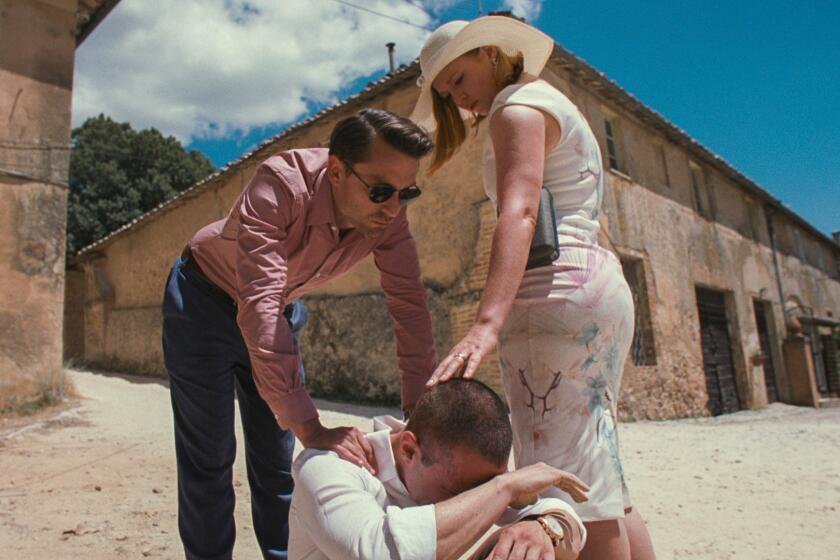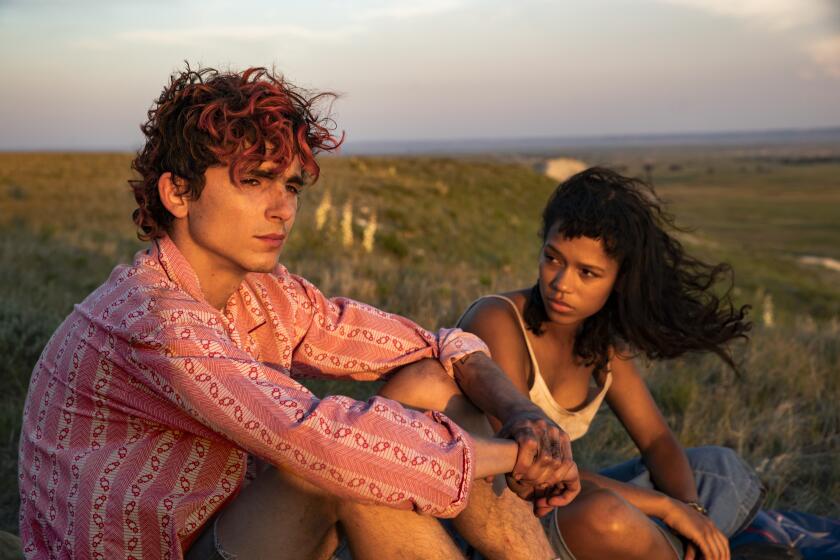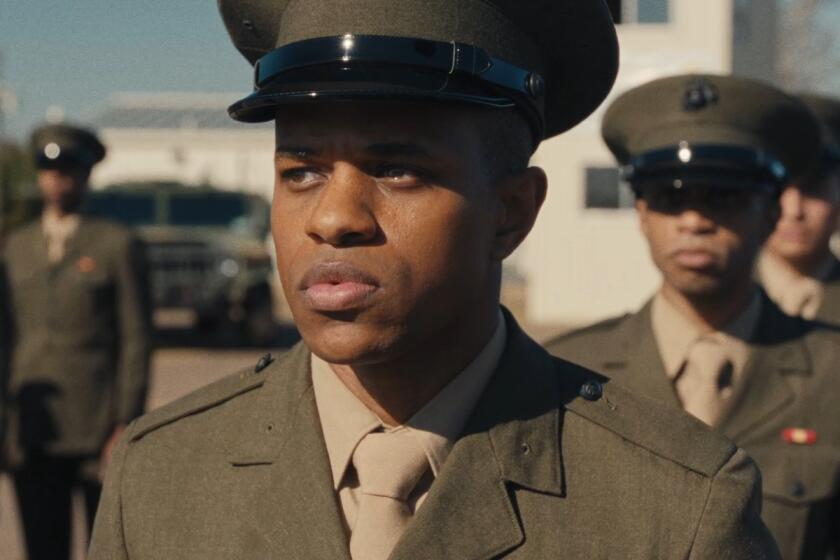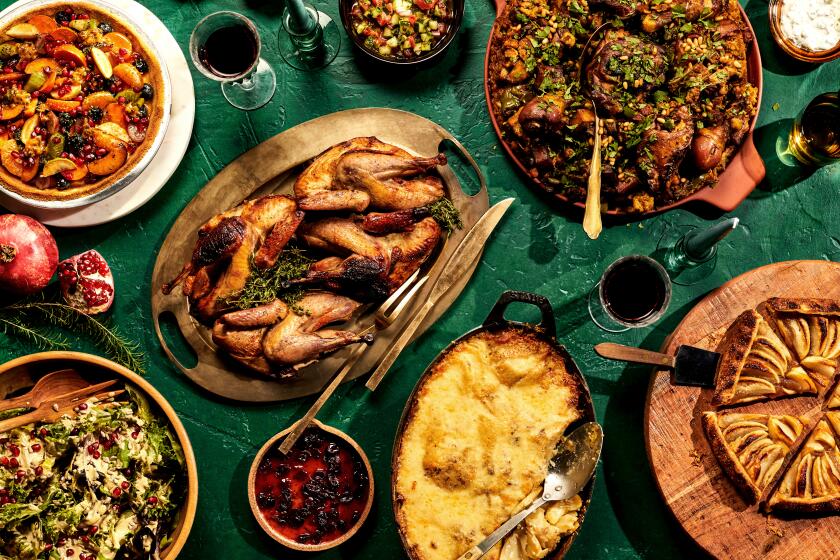How ‘The Menu’ got the horrors of high-end fine dining right
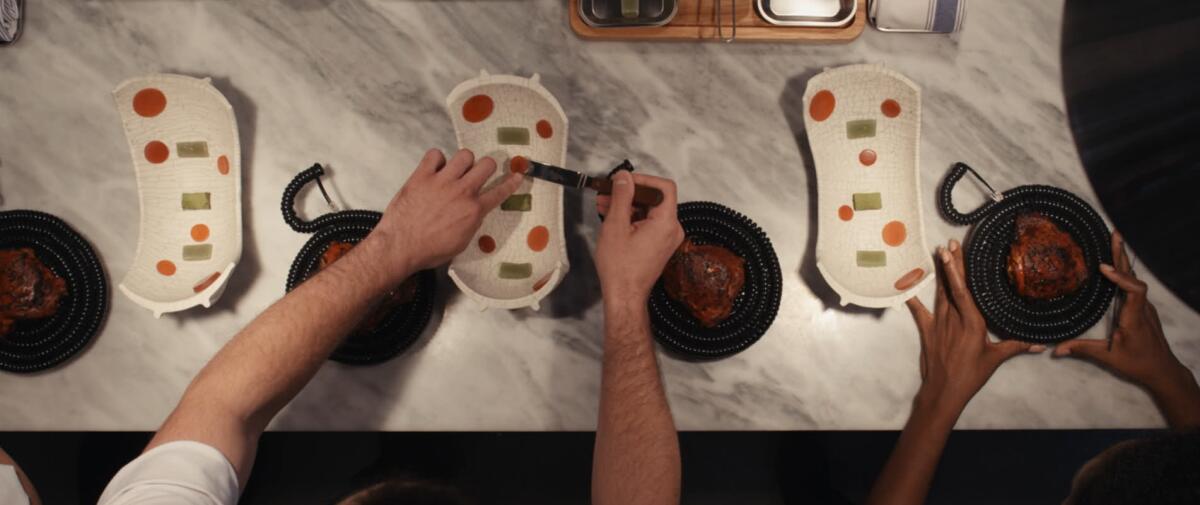
- Share via
One of the world’s most anticipated restaurants will debut this week, but it’s even more ephemeral than a pop-up. In fact, the waterfront dining room and the meticulously prepared tasting menu have already dematerialized. To experience Hawthorne, you’ll have to visit a movie theater.
The fictional restaurant at the center of the new thriller “The Menu,” out Nov. 18, serves not only memorable plates — bone marrow and seared steak and freshly plucked scallops arranged with gels and foraged rocks — but also scathing commentary on class, idolatry and consumerism that extends far beyond the dining room overseen by the meticulous and malevolent Chef Julian Slowik (Ralph Fiennes).
Creating that world authentically, down to the procession of showy courses sometimes humorous, sometimes violent, took a team of A-list professionals, including an Emmy-winning producer and one of the most decorated chefs in the country.
Director Mark Mylod (“Succession,” “Game of Thrones”) describes his own palate as “primitive” and “peasant”-like, so he found the prospect of making a film about the unraveling of a top chef daunting, albeit fascinating.
“I knew very, very little about that high-end world of molecular gastronomy,” he said. “A few years ago, that would have probably pushed me away out of fear, but instead, I went the other way and thought, ‘OK, let’s dive in. Let’s explore that world.’”
A shot in the Season 3 finale featuring three Roy siblings has stunned viewers, with some even comparing it to Renaissance art. Experts break it down.
To help create a tasting menu wherein the severe but black-humored chef treats — and punishes — guests over the course of one eventful dinner, production designer Ethan Tobman (“Pam & Tommy,” “Free Guy”) signed on to fulfill a lifelong dream of designing a restaurant (even a fictional one). Slowik, he said, captured his attention and inspired what he calls “emotional architecture”: building a set around a character’s pathology.
Slowik’s character also drew in Dominique Crenn, who was astounded when she read the script. The chef of San Francisco’s Atelier Crenn creates her own menus in the forms of poems, evoking imagery such as “the setting of a purple sun” and “whimsically ebullient blue umami.” She could understand the artistry and determination of the embattled Slowik, as well as his years of pain in an industry rife with abuse, critique and perfectionism at any cost. Hoping to bring not only authenticity but also an empathy for Fiennes’ character, Crenn jumped at the opportunity to serve as culinary consultant.
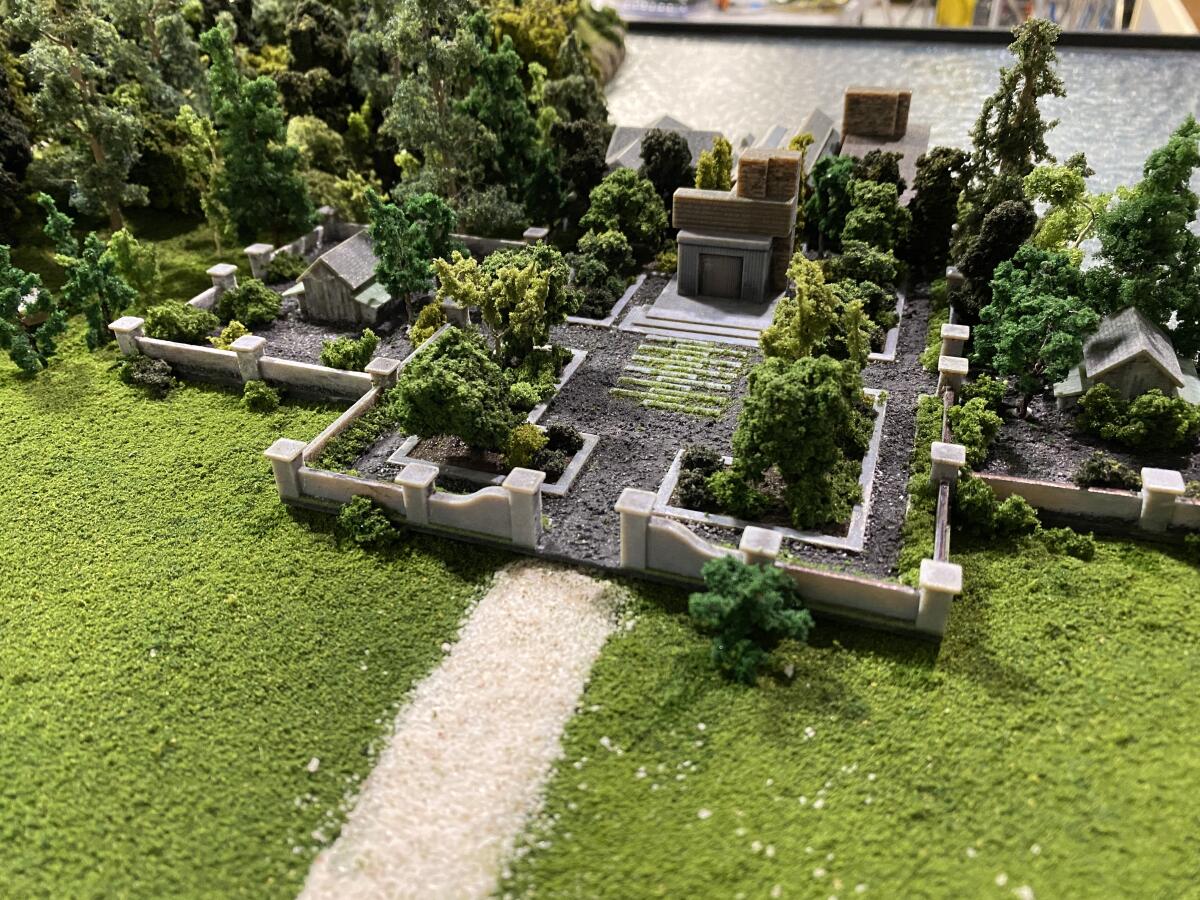
“It was a complete foreign landscape for all of us,” Tobman said. “Here we have a three-star Michelin chef who’s never taken creative direction from anyone else; she’s autonomous. She is an artist of the highest order. We have a screenplay that’s pretty specific about what some of those dishes need to be, and then you have a production designer who is trying to make all of that aesthetically pleasing with the environment, but also portray some of the emotional tensions that change from scene to scene, and use the dishes as a conduit for that. None of us knew how to do this.”
They began with mood and theme.
The designer drew on his art-history background, providing Mylod with visual references such as painter Francis Bacon’s “Study After Velázquez’s Portrait of Pope Innocent X” — a jarring depiction of the pope burning alive — and macabre still lifes by Dutch masters presenting animals staked through.
Timothée Chalamet and Taylor Russell star as two young people driven by a desire they struggle to understand in Luca Guadagnino’s haunting romantic horror film.
The production team reimagined a locale on Georgia’s Tybee Island as one of the country’s most exclusive restaurants, accessible only by private ferry — the remoteness accentuating the diners’ isolation and dependence. They brought in their own black mulch and white limestone and constructed a swiveling, menacing door, obscuring an old barn where couples are often married on the property. The team constructed the exterior, the front door and 30 feet of entrance hallway on location, then built the dining room in a warehouse with dozens of feet of grass on the “outside” to tie the real location to the fake.
For all the wood and moss, Hawthorne feels almost austere, not unlike many of the restaurants one might find on a list of the world’s 50 best. “It is weird, isn’t it?” Tobman asked. “You pay to be there and it’s supposed to delight all the senses, but there’s a tiny little bit of you that does feel like you’re in prison.”
This, Mylod says, is crucial to building suspense and unease within “The Menu.”

“We spend our lives in the writers room on ‘Succession’ trying to think of as many ways that we can get our characters into a space where they can be trapped and bounce off each other — and the restaurant offers that gift of a contained space to brew tension and to break that tension with comedy.”
The layout of the primary set — a dining room attached to an open kitchen — helps to underscore the divide between “the givers” and “the takers,” or those who provide labor and experiences versus those who so easily, often thoughtlessly, consume. The disdain, practically oozing from Slowik as the menu progresses, is on clear display for those $1,250-per-head seats. Even before the courses turn ominous and the chef’s devious intention for the evening is made clear, there’s bisection.
“We can feel the military presence or military threat of our cooks going about that relentless metronome of their preparation in the kitchen,” Mylod said. “One swings 180 degrees from that and gets that beautiful asymmetric glass window looking over the ocean that represents freedom, nature, all the things that have been left behind by both our cooks and our diners. And as the light recedes on that, as the sun goes down, we see that dream dissipating before our eyes.”
Jeremy Pope stars in Elegance Bratton’s strong debut film about his experience as a gay Black man who joins the U.S. Marine Corps.
Another theme Mylod and Tobman agreed upon was cult-like reverence, riffing on a kind of fanatical devotion held by and for chefs within a kitchen hierarchy and by the diners who fetishize them. Nicholas Hoult, playing an enthusiastic, camera-happy foodie, worships at the altar of Slowik to his own detriment, while his date, played by Anya Taylor-Joy, looks on skeptically. At Hawthorne, Slowik mans the pulpit at the kitchen’s center — a kind of soap-box shape with a cross on the back wall behind him — lighted almost as if he were a preacher, while his cooks, in the foreground, stand on a floor slightly lower so as to appear to be genuflecting, per Tobman’s design.
While the set was being finished, Crenn, her team and Savannah, Ga., chef John Benhase held a sort of culinary boot camp for the onscreen staff to ensure that every motion on-camera looked authentic, though nearly all kitchen extras worked as cooks professionally outside the film.
“It was not just about the detail of the food; it was a detail of everything that was placed, the movement, the dance, the way that the server will carry the bottle, or the sommelier,” Crenn said. “Attention to detail is a part of my life, and to bring that to that set was just incredible for me. It was very organic.”
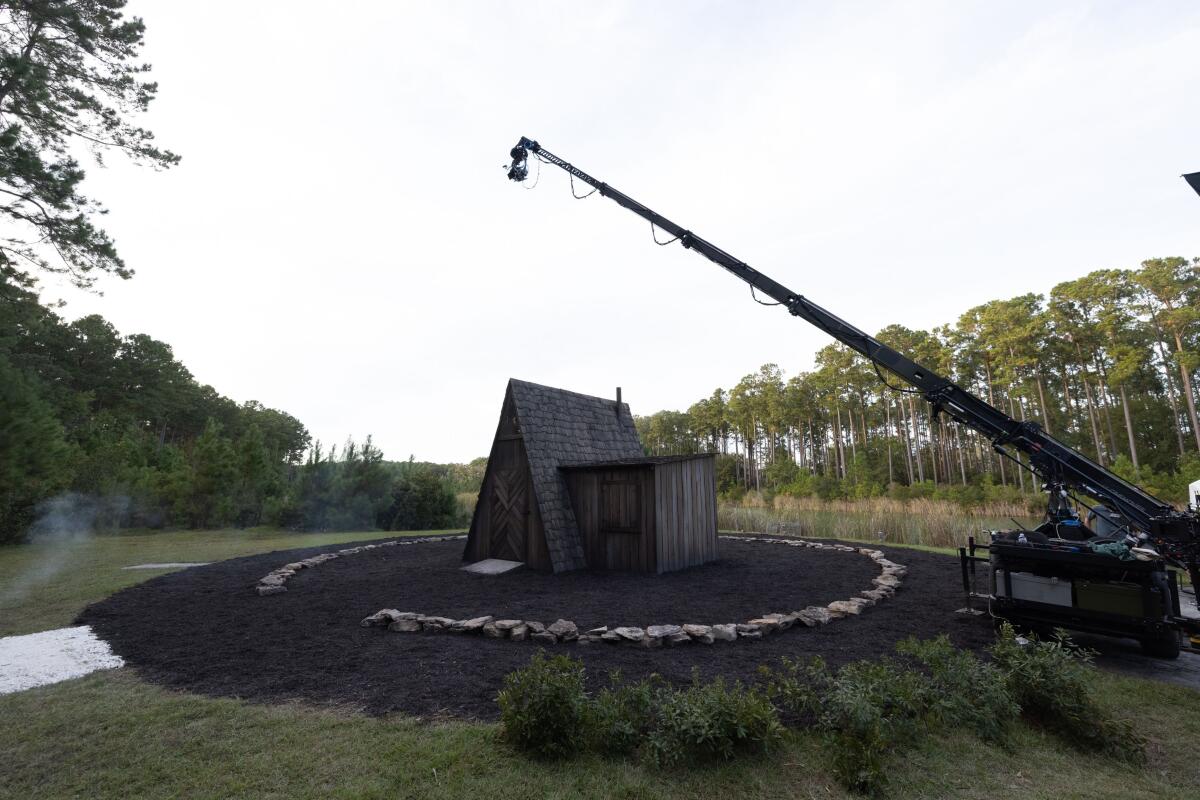
Crenn also coached Fiennes, helping him to understand not only the headspace of his character but also the mannerisms of a tenured, Michelin-pedigreed chef at the end of his rope. “I said, ‘It’s not about being a good chef, it’s about being a conductor — you’re the conductor of the symphony, and you have to have the confidence, and attention to detail is everything,’” she said.
The physical aspects of the restaurant — the lighting, the signage, the placements — also sought to re-create the intimate tasting menu experience, even down to items not visible onscreen.
Tobman and art director Lindsey Moran would sneak into the kitchens of restaurants they’d be dining in (read: researching) and ask for a quick tour to jot down the minutiae; they found that at every level of restaurant, from the French Laundry to McDonald’s, cooks worked elbow to elbow. Some told Tobman that at home, after a shift, they have trouble spreading out on their beds after hours under those conditions. This cramped proximity, of course, made its way into “The Menu” as well, ratcheting up the film’s claustrophobic air.
Saffy’s in East Hollywood delivers sun-soaked flavors and another success to the Bestia and Bavel team
Because Crenn wanted to plate real high-end food for the lead actors to help create that emotional response with every bite, food stylist Kendall Gensler and Crenn collaborated to ensure the dishes could withstand the hours of shooting.
“How do you make dehydrated leaves and frothy crab emulsions stick for 12 hours?” Tobman asked. “[Gensler] was incredible and worked closely with chef Crenn’s team to develop a laboratory of tricks to really trick the viewer into thinking things were one thing and not another, while also [being sure] to make them edible.”
Crenn and Tobman created a mood board for the dishes served — their ingredients, their plating and their storytelling — as well as the vessels, or the plate ware, that would carry them.
Sometimes the script fully fleshed out the courses — for example, chicken speared through with scissors and featuring phone cord, tied pointedly to a monologue by Slowik detailing a particularly traumatic, decades-old evening in his household. One scene demanded tortillas emblazoned with the guests’ visages; at what Tobman calls the eleventh hour, they found a laser that could etch the tortillas without marring the food.
Otherwise, they were given wide latitude — especially for the final course of the menu, noted only in the script as being an impressive s’mores presentation. Tobman turned to chef Grant Achatz’s famed Jackson Pollock-like dessert, the final course at Chicago’s Alinea, drawing inspiration from the live-drawn tabletop painting of swirls of chocolate and color. But how would the filmmakers re-create something of that artistry and flare spread across a 30- by 60-foot space? It became a kind of math equation, drawn onto a grid, projected onto the floor and traced with blacklight markers.
“It was the hardest thing I’ve ever had to do for a movie,” Tobman said, “and also the most deeply OCD-satisfying.”
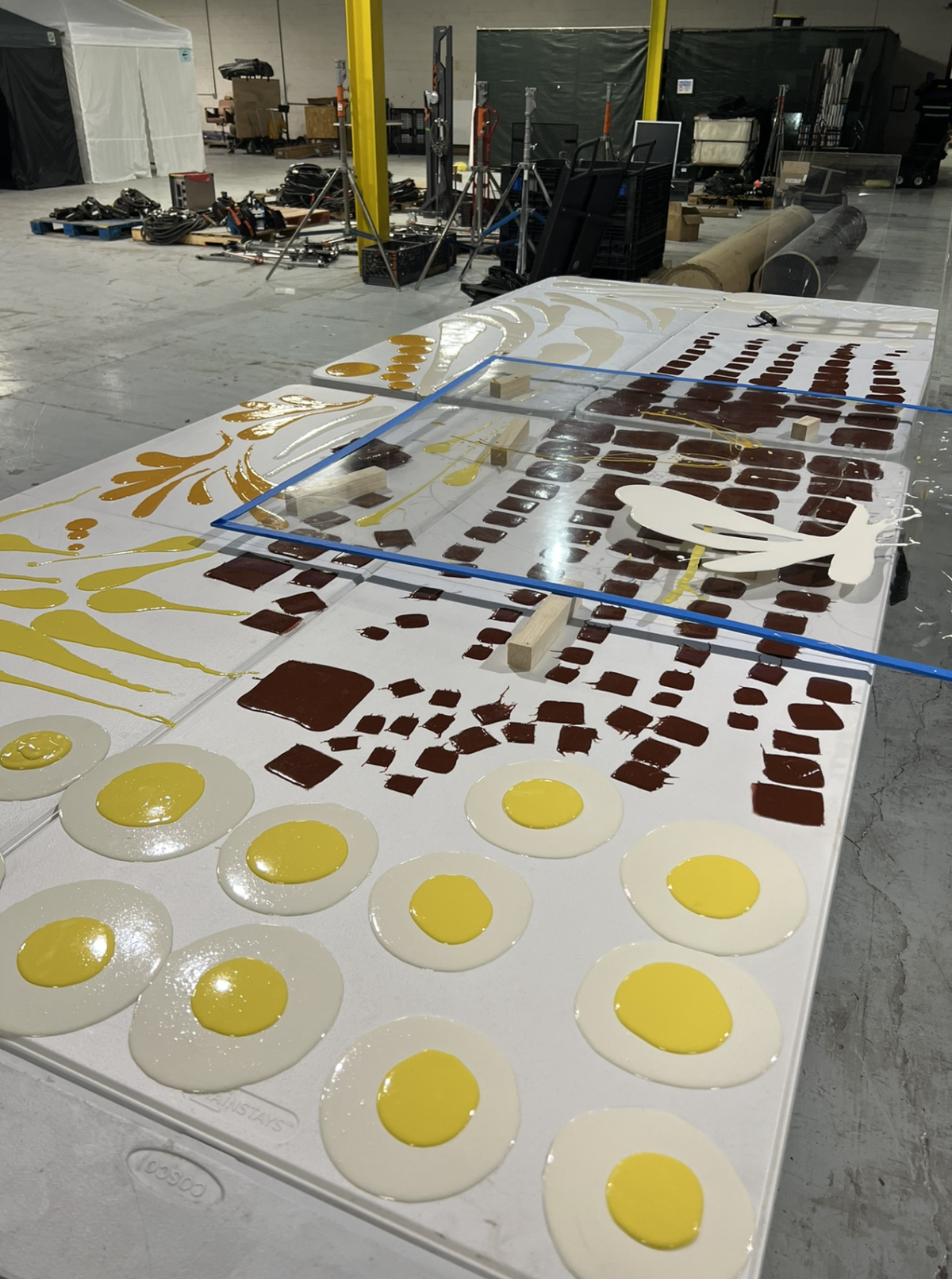
The chocolates and sauces had to appear as though they were deliberately flung out of ladles as the guests looked on, but also would have to last for four days of shooting and, on top of it all, withstand fire. When the cast wasn’t rehearsing in the space, Tobman and his team attached a GoPro to the ceiling and filmed themselves mock-plating the dessert to choreograph the movements and using various substances: Could the orange be made with puréed carrots? Could the white be liquified marshmallow? Could the yellow be cake batter? These ingredients proved too inconsistent, and none lasted longer than 20 minutes before losing shape. They eventually traced the layout of the dessert’s final design and cast resin models of the “food” splatters, color-coded them, numbered them and then traced them with blacklight markers on the set so as to not be visible on camera.
The result? A mix of live plating and movie magic for large-scale, show-stopping s’mores arrayed across the dining room floor and tabletops and guests themselves.
“We shot the scene and then right in front of the actors, the lights turned off, the black lights turned on — it looked like a crime scene — and six of us attacked it, placing our exact shapes exactly where they needed to go,” Tobman said. “It was such a thing of beauty, and the cast just looked at us incredulously as this 1,800-square-foot dessert materialized before their eyes. Mark [Mylod] was loving it because it’s one of those things that only happens when food and film combine.”
Celebratory chicken and rice, potato gratin, roast pheasants and apple galette — these L.A. home cooks are making Thanksgiving their own.
The combined efforts — of film and food, and of Crenn, Tobman, Mylod, Gensler, Benhase and countless others — has garnered near-unanimous approval from the culinary community in advance screenings. The best feedback the director has received so far has come directly from members of the service industry who’ve told him they finally felt seen on film; Mylod said he was so happy he could have cried.
These efforts won’t end with the final cut of “The Menu”; in collaborating to bring Hawthorne to life, Crenn and Tobman formed a new partnership and friendship, and the production designer’s current project is reimagining the chef’s Atelier Crenn, set to reopen in early 2023.
Crenn, who sees so much of herself in Slowik, hopes their meticulous work on the film inspires viewers and diners to approach restaurants with compassion and not, as one might believe after watching “The Menu,” abject fear.
“[T]hink differently about the people that work in the restaurant and maybe [bring] more kindness and thoughtfulness and consciousness,” Crenn said. “That’s all I’m asking.”
More to Read
Only good movies
Get the Indie Focus newsletter, Mark Olsen's weekly guide to the world of cinema.
You may occasionally receive promotional content from the Los Angeles Times.
